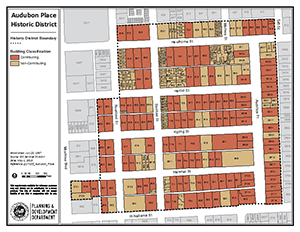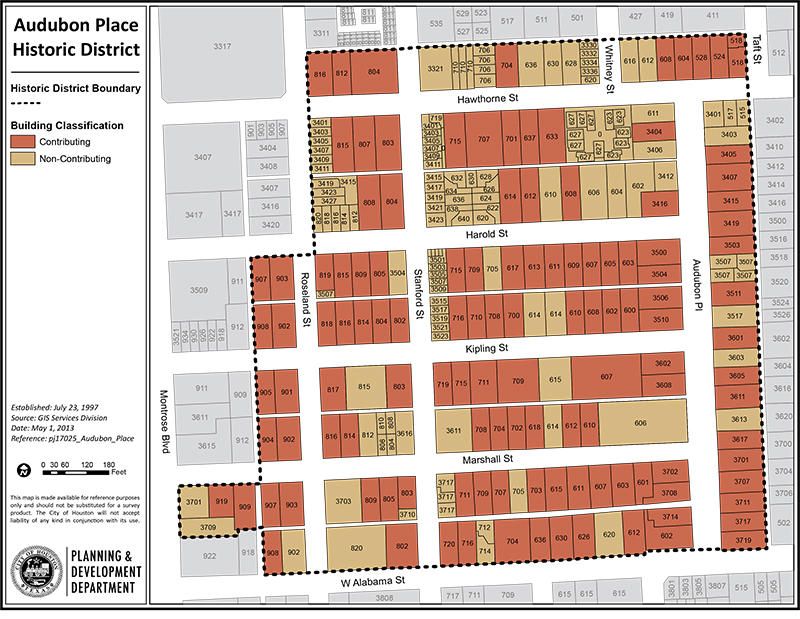Audubon Place

About
The Audubon Place Historic District is part of the original Montrose Addition developed in the 1910s and 1920s. The District is centered around the Audubon Place boulevard.
Houston has been a major shipping and trade center since its founding in 1836. During the 1800s, city leaders invested in the development of railroads and Houston’s network of bayous. The Houston Ship Channel and Port of Houston were built in the early 1900s. All of this development drove the city’s tremendous growth, and between 1900 and 1910 the city’s population doubled.
The town became crowded. Many wealthy professionals who had lived in or near downtown began to move into the new, exclusive neighborhoods built to the north and southwest of downtown. Courtlandt Place, Westmoreland, and Avondale were some of the most notable southwestern suburbs of the day They were the outer limits of Houston’s development. Beyond these neighborhoods, where the Montrose Addition would be built, the land was open prairie and pasture.
Montrose was the first large-scale, restricted planned subdivision. It was platted in 1911 by the Houston Land Corporation. The company’s owner, John Wiley Link, bought a 3,370-acre tract of land southwest of downtown. He named the area after an historic town in Scotland. Link hired the Stone & Webster engineering and construction company to design the subdivision.
The company platted more than 1,000 lots and spent more than $1,000,000 on streets, utilities, and other improvements. When it was first developed, Montrose contained 11 of the 26 miles of paved roads then in Houston. It had 22 miles of concrete curbs and sidewalks, eight miles of sanitary sewers, and seven miles of water mains. The Montrose line of the Houston Electric Railway Company began providing streetcar service between the neighborhood and downtown in August 1912. Its turnaround point was at the intersection of Roseland and West Main Streets. The streetcars ran in Houston until 1937.
Some of the most important features of the Montrose neighborhood are its grand boulevards with esplanades. The boulevards in Montrose include Lovett, Montrose, Yoakum, and Audubon Place Boulevards. The idea was to build large mansions along the boulevards, facing the esplanades. Edward Teas, Sr., who later founded Teas Nursery, helped plan and landscape the neighborhood.
To attract buyers to the new development, John Link built the first mansion on Montrose Boulevard in 1912. The house, at 3800 Montrose Boulevard, was built for Link himself by the architecture firm of Sanguinet, Staats & Barnes of Fort Worth. Link sold the home in 1916 to Thomas Lee, a leader in the burgeoning oil industry, for $90,000. The house is now known as the Link-Lee Mansion and is a City Landmark. It is now the administration building for St. Thomas University.
Many other prominent Houstonians built mansions on the boulevards. However, Link never meant for Montrose to be an exclusive neighborhood only for the rich. The lots on cross streets between the boulevards were priced for middle-class families. Those streets included Hawthorne, Harold, Kipling, Oxford (now Marshall), Conner (now Stanford), and Terry (now Roseland).
The neighborhood developed rapidly over the next 10 years. Some of Houston’s most prominent citizens built houses in and around Audubon Place Boulevard. Their homes reflected the architectural styles that were popular at the time. These include Craftsman, Prairie, Mission Revival, Colonial Revival, Queen Anne, Cape Cod, and Art Deco. Many respected architects and builders created houses in the neighborhood.
While Montrose was originally platted as one neighborhood, over time the sections around each of the four boulevards established their own identities. Despite their individuality, they all suffered decline beginning in the mid-1940s. After World War II, many families moved to new suburbs and commercial and institutional development gradually crept into the neighborhood. Many of the mansions were demolished and many of the more modest homes became used for commercial operations.
Audubon Place is now the last remaining mostly-residential section within the original boundaries of Montrose. Over time, many people recognized the area’s charm and historical significance. They purchased neglected buildings and restored them. In the 1990s, residents organized the Audubon Place Civic Association. In 1995, they successfully reinstated deed restrictions to manage the character of the neighborhood. They have also raised money and worked together to improve and beautify the area.
Categories
Navigation
- Audubon Place
- Avondale East and Avondale West
- Boulevard Oaks
- Broadacres
- Courtlandt Place
- First Montrose Commons
- Freeland
- Germantown
- Glenbrook Valley
- High First Ward
- Houston Heights East, South and West
- Main Street Market Square
- Norhill
- Old Sixth Ward
- Shadow Lawn
- Starkweather
- West Eleventh Place
- Westmoreland
- Woodland Heights
